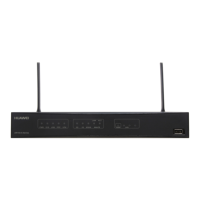7.1 Introduction to Fault Management
Through detecting, diagnosing, isolating, and rectifying the existing or potential fault, and then
generating the relevant alarm or precaution alarm, fault management can rectify the fault or
minimize the impact of the fault on system running, enhance the fault tolerance capability of the
system, and improve the system reliability.
7.2 Fault Management Features Supported by the AR150/200
The AR150/200 supports alarm management and event management. Configuring alarm or event
severities and correlation suppression can control the output of alarms or events.
7.3 Configuring Alarm Management
The configurations of alarm management include the alarm severity level, delayed alarm
reporting and correlated alarm suppression.
7.3.1 Establishing the Configuration Task
Before configuring alarm management, familiarize yourself with the applicable environment,
complete the pre-configuration tasks, and obtain the required data. This will help you complete
the configuration task quickly and accurately.
Applicable Environment
Alarm management includes setting alarm severities, enabling alarm report delay, and enabling
interface-based alarm filtering.
Pre-configuration Tasks
Before configuring alarm management, complete the following task:
l Installing system software to the router and powering it on
Data Preparation
Before configuring alarm management, you need the following data.
No.
Data
1 Alarm name
Huawei AR150&200 Series Enterprise Routers
Configuration Guide - Device Management 7 Fault Management
Issue 02 (2012-03-30) Huawei Proprietary and Confidential
Copyright © Huawei Technologies Co., Ltd.
113

